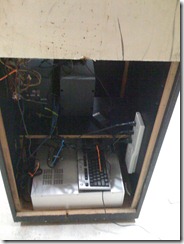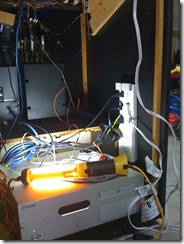Building your own Arcade Cabinet for Geeks - Part 6 - Computer Hardware and Software
This is the sixth part of a multi-part series I'm going to do about assembling an Arcade Cabinet for my house. This series has two disclaimers:
Software Disclaimer 1: There's all sorts of legal issues around emulating arcade games. This series of posts has nothing to do with that. I do own some original arcade boards, but if you want to emulate arcade games with MAME (Multiple Arcade Machine Emulator), you can search the 'tubes. What I'm doing here is putting a computer in a pretty box.
Hardware Disclaimer 2: Many folks that build arcade cabinets have a purist view of how these things should be done. They will prefer original Arcade CRT monitors and more expensive, higher quality parts. I am more of a pragmatist. I also have no idea what I'm doing, so I've also got ignorance on my side.
Hardware
I, like most geeks, have a number of old computers lying around. I picked the best one, a Pentium 4 I used to use as a Media Center. It has a gig of RAM, runs Windows XP SP3 and has a nice fast ATI video card. I figured since I am just as interested in regular games as I am in Arcade Classics, it'd behoove me to have a decent machine in there.
The insides are HUGE as I yanked out the original arcade guts. There's lots of room and the back has two holes cut with screendoor material over them. I haven't had a heat problem yet, but I suspose I could easily add a small desk fan to blow air out the back. It would turn on with the rest of the equipment.
I setup a Microsoft Wireless Desktop 6000 mouse and keyboard (to avoid cords) and I may mount a sack or something on the back to hold them. I also plugged in a Wireless Xbox Controller and Xbox USB Gaming Receiver for games like Far Cry.
Software
I put lots of emulators for classics like C64, SNS, Ataris and other old hardware I have lying around. I set a few important BIOS settings that you shouldn't miss.
First:
- Set your Power BIOS setting to "Always On" or "On After Power Loss."
- Set your BIOS to "quick" or "silent" in order to speed up the boot.
- Use "msconfig.exe" to set the time that Windows waits to boot up to some small number like 3 seconds.
- Configure XP to automatically logon as some user of your choice, per KB3152321.
There's a number of popular "Front Ends" that you can put in your Startup Folder. Some folks replace Explorer.exe as the shell, but I think that's excessive. I just set my launcher to start immediately .
If you're looking for the prettiest, most "art focused" front end, then there is no other front-end than HyperSpin. It uses a file-based system of transparent PNGs and AVIs along with a compositing engine to make a truly beautiful circular menuing system.
Software is one of those things I'll spend the next year getting just the way I want it.
Next Up: Success and Conclusion
- Cabinet and Power
- Monitor and Mounting
- Control Panel
- Sound and Lights
- Paint and Art
- Computer Hardware and Software
- Success and Conclusion
About Scott
Scott Hanselman is a former professor, former Chief Architect in finance, now speaker, consultant, father, diabetic, and Microsoft employee. He is a failed stand-up comic, a cornrower, and a book author.
About Newsletter
I gotta say gonna an xbox to build mine... an emu called coin ops and also final burn....
Hyperspin-fe looks pretty freakin cool
Comments are closed.



My 6 year old would have to go back in diapers if I built this because he'd crap his pants. In fact, so would I!
We have a Wii but it is too much trouble to switch the inputs, unpack the controllers, switch the game (uh, anybody seen maternational?) and the games are just too much these days. I miss the days of Mari Bros where you just trample a few turtles and feel better for having done it.
...and Metroid. I sure loved Metroid.